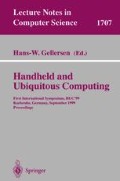Abstract
Direct manipulation, which is the dominating “interaction style” for mobile computers, fails to meet the conditions of many mobile use situations. In particular, it demands too much visual attention of the user. We introduce a new, complementing interaction style (and system) for mobile computers, called MOTILE, which addresses three main requirements of interaction with mobile computers: (1) no visual attention needed; (2) structured, tactile input, and; (3) the use of audio feedback. MOTILE relies on only 4 buttons for user input and “hands free” audio for feedback.
Acknowledgements
The Mobile Informatics research program of the Swedish Information Technology Institute (SITI), and the MoBEE project with grants from the Research Council of Norway funded this research.
Access this chapter
Tax calculation will be finalised at checkout
Purchases are for personal use only
Preview
Unable to display preview. Download preview PDF.
References
Hinckley, K., et al. (1998) “Two-handed virtual manipulation,” ACM Transactions on Computer-Human Interaction, Vol. 5, No. 3, p. 260–302.
Nielsen, J. (1993) Usability engineering, San Diego, CA: Academic Press.
Shneiderman, B. (1998) Designing the user interface. Strategies for effective Human-Computer interaction, Third edition, Reading, MA: Addison-Wesley.
Norman, D. (1988) The psychology of everyday things, USA: Basic Books.
Ishii, H. and B. Ullmer (1997) “Tangible bits: Towards seamless interfaces between people, bits and atoms,” in Proceedings of ACM 1997 SIGCHI Conference on Human Factors in Computing Systems, ACM Press.
Sawhney, N. and C. Schmandt (1999) “Nomadic Radio: Scalable and contextual notification for wearab le audio messaging,” in Proceedings of ACM 1999 SIGCHI Conference on Human Factors in Computing Systems, ACM Press.
Hindus, D., C. Schmandt, and C. Horner (1993) “Capturing, structuring, and representing ubiquitous audio,” ACM Transactions of Information Systems, Vol. 11, No. 4, p. 376–400.
Brewster, S. (1998) “Using Nonspeech Sounds to Provide Navigation Cues,” ACM Transaction on CHI, Vol. 5, No. 3, p. 224–259.
MacKenzie, S., A. Sellen, and W.A. S. Buxton (1991) “A comparison of input devices in element pointing and dragging tasks;,” in Proceedings of ACM 1994 Conference on Human Factors in Computing Systems, ACM Press.
Jacob, R.J.K., et al. (1994) “Integrality and Separability of Input Devices,” ACM Transactions on Computer-Human Interaction, Vol. 1, No. 1, p. 3–26.
Author information
Authors and Affiliations
Editor information
Editors and Affiliations
Rights and permissions
Copyright information
© 1999 Springer-Verlag Berlin Heidelberg
About this paper
Cite this paper
Kristoffersen, S., Ljungberg, F. (1999). Designing Interaction Styles for a Mobile Use Context. In: Gellersen, HW. (eds) Handheld and Ubiquitous Computing. HUC 1999. Lecture Notes in Computer Science, vol 1707. Springer, Berlin, Heidelberg. https://doi.org/10.1007/3-540-48157-5_26
Download citation
DOI: https://doi.org/10.1007/3-540-48157-5_26
Published:
Publisher Name: Springer, Berlin, Heidelberg
Print ISBN: 978-3-540-66550-2
Online ISBN: 978-3-540-48157-7
eBook Packages: Springer Book Archive

